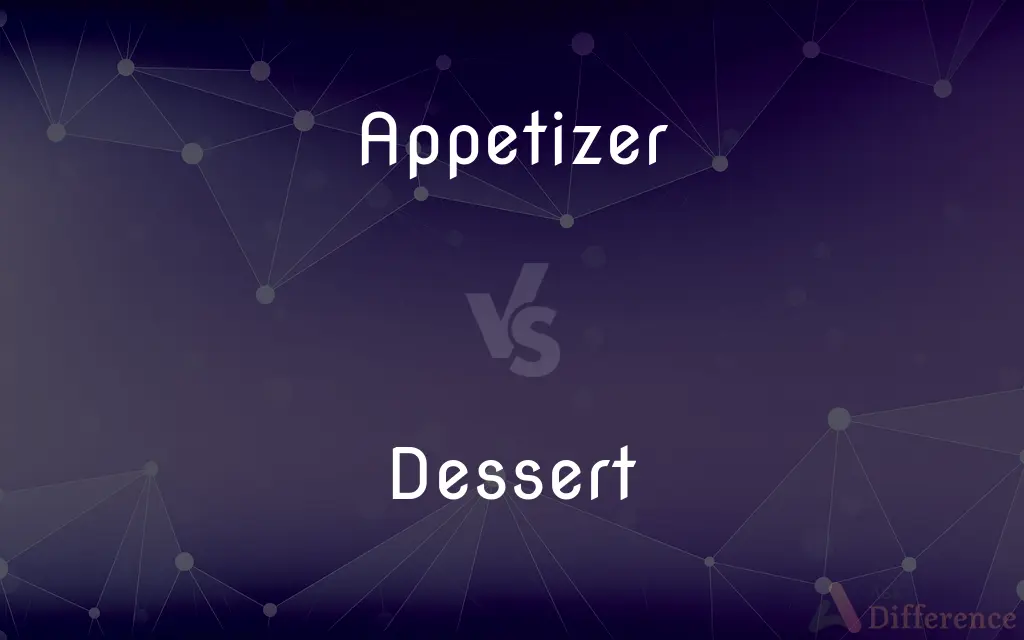Appetizer vs. Dessert — What's the Difference?
Edited by Tayyaba Rehman — By Urooj Arif — Updated on February 22, 2024
Appetizers are small dishes served before a meal to stimulate the appetite, while desserts are sweet courses served at the end of a meal.

Difference Between Appetizer and Dessert
Table of Contents
ADVERTISEMENT
Key Differences
Appetizers are designed to be light and flavorful, often intended to prepare the palate for the main courses to come. They can range from simple dishes like soups and salads to more complex offerings such as bruschetta or shrimp cocktail. In contrast, desserts typically consist of sweet foods like cakes, cookies, and ice cream, aimed at concluding the meal on a satisfying note.
The serving size of appetizers is generally small, allowing diners to enjoy the main course without becoming too full. Appetizers are meant to whet the appetite rather than satiate hunger completely. Desserts, on the other hand, are served after the meal has concluded, often in portions that allow for a shared experience among diners. The size and sweetness of desserts are designed to offer a final, indulgent taste without overwhelming the palate.
Appetizers play a crucial role in pacing the meal, providing a transition from the arrival at the dining table to the main dishes. They set the stage for the meal's flavor profile and can vary widely depending on the cuisine. Desserts serve as the finale of the meal, offering a moment of indulgence and often reflecting the meal's overall theme or the diner's personal taste preferences.
The choice of appetizers can greatly influence a diner's anticipation and expectations for the meal, showcasing the chef's style and the menu's theme. Desserts, while concluding the meal, leave a lasting impression, contributing significantly to the meal's overall satisfaction. Both courses offer opportunities for culinary creativity, but they serve different purposes in the dining experience.
Culturally, appetizers and desserts hold different significances and traditions across cuisines. For example, in some cultures, multiple appetizers are served as a meal in themselves, known as tapas or mezze, focusing on variety and social dining. Conversely, desserts may vary from simple fruits to elaborate pastries, reflecting local ingredients and culinary heritage.
ADVERTISEMENT
Comparison Chart
Purpose
To stimulate the appetite before a meal.
To provide a sweet conclusion to a meal.
Serving Size
Small, to avoid filling up the diner.
Often larger than appetizers, meant for indulgence.
Timing
Served at the beginning of a meal.
Served at the end of a meal.
Types
Can include soups, salads, and finger foods.
Includes cakes, cookies, ice cream, and more.
Cultural Significance
May vary widely; in some cultures, served as a main meal (tapas, mezze).
Reflects local ingredients and traditions, ranging from simple to elaborate.
Compare with Definitions
Appetizer
Often light and savory.
The chef prepared a delicate mushroom tart as the appetizer.
Dessert
A sweet course served at the end of a meal.
We ended our dinner with a decadent chocolate lava cake for dessert.
Appetizer
Can be served cold or hot.
Our appetizer was a chilled gazpacho on a hot summer day.
Dessert
Can range from simple fruits to elaborate pastries.
For dessert, there was a choice between fresh fruit or crème brûlée.
Appetizer
A small dish served before the main course to stimulate the appetite.
For an appetizer, we enjoyed a plate of oysters on the half shell.
Dessert
Serves as the meal's finale, leaving a lasting impression.
The dessert, a homemade apple pie, was the highlight of the evening.
Appetizer
Designed to introduce the meal's flavor profile.
The spicy tuna appetizer set the stage for the sushi meal that followed.
Dessert
Reflects the meal's theme or special occasion.
The wedding cake served as a dessert, symbolizing the couple's sweet future.
Appetizer
Encourages social interaction at the table.
Sharing an appetizer platter got everyone talking and laughing.
Dessert
Often shared among diners.
We shared a large slice of cheesecake for dessert, enjoying every bite.
Appetizer
A food or drink served usually before a meal to stimulate the appetite.
Dessert
The last course of a meal, consisting of fruit, sweet confections etc.
I ordered hummus for a starter, a steak as the main course, and chocolate cake for dessert.
Can I see the dessert menu, please?
Appetizer
Food or drink to stimulate the appetite (usually served before a meal or as the first course)
Dessert
Dessert () is a course that concludes a meal. The course consists of sweet foods, such as confections, and possibly a beverage such as dessert wine and liqueur.
Dessert
A sweet dish or confection served as the last course of a meal.
Trifle is a favourite dessert of the English, but rivalled by pavlova in Australia and New Zealand.
Dessert
A usually sweet course or dish, as of fruit, ice cream, or pastry, served at the end of a meal.
Common Curiosities
Is it necessary to have both an appetizer and a dessert in a meal?
It is not necessary to have both; the inclusion of appetizers and desserts depends on the meal's formality, cultural traditions, and personal preferences.
Can desserts be healthy?
Yes, desserts can be healthy, especially when made with fruits, nuts, and other natural, nutritious ingredients.
How do cultural differences influence appetizers and desserts?
Cultural differences can significantly influence the types, ingredients, and significance of appetizers and desserts, reflecting local culinary traditions.
How do appetizers differ from entrees?
Appetizers are smaller, lighter dishes meant to stimulate the appetite, while entrees are the main course, larger and intended to be the meal's focal point.
Are appetizers shared?
Appetizers can be individual or shared, depending on the dish and dining tradition.
Can a dessert be savory?
While desserts are typically sweet, some cultures offer savory options, such as cheese plates, as a dessert course.
What makes a good dessert?
A good dessert balances sweetness with flavor, complements the preceding meal, and satisfies the diner's craving for a sweet conclusion.
What is a typical dessert in French cuisine?
A typical dessert in French cuisine might be a tarte tatin, crème brûlée, or a selection of cheeses.
What is the purpose of an appetizer?
The purpose of an appetizer is to stimulate the appetite and prepare the palate for the main course.
Why are appetizers important in a meal?
Appetizers are important as they set the tone for the meal, offering a preview of the culinary style and stimulating the diner's appetite.
What role does presentation play in appetizers and desserts?
Presentation plays a crucial role in both appetizers and desserts, enhancing the dining experience through visual appeal and setting expectations.
How do appetizers set the stage for a meal?
Appetizers introduce the meal's flavor profile and theme, engaging the diner's senses and building anticipation for the courses to follow.
How can dietary restrictions be accommodated with desserts?
Dietary restrictions can be accommodated by offering desserts with alternative ingredients, such as gluten-free, dairy-free, or sugar-free options.
Can appetizers or desserts be skipped in a meal?
Yes, either course can be skipped based on the diner's preference, dietary restrictions, or the meal's context.
Is it common to have multiple appetizers or desserts in a meal?
In formal dining or tasting menus, it is common to have multiple appetizers or desserts, offering a variety of flavors and textures.
Share Your Discovery

Previous Comparison
Enabled vs. Disabled
Next Comparison
Phony vs. HypocriteAuthor Spotlight
Written by
Urooj ArifUrooj is a skilled content writer at Ask Difference, known for her exceptional ability to simplify complex topics into engaging and informative content. With a passion for research and a flair for clear, concise writing, she consistently delivers articles that resonate with our diverse audience.
Edited by
Tayyaba RehmanTayyaba Rehman is a distinguished writer, currently serving as a primary contributor to askdifference.com. As a researcher in semantics and etymology, Tayyaba's passion for the complexity of languages and their distinctions has found a perfect home on the platform. Tayyaba delves into the intricacies of language, distinguishing between commonly confused words and phrases, thereby providing clarity for readers worldwide.














































